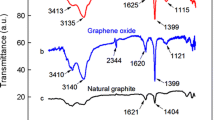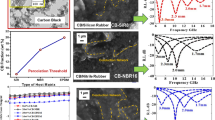Abstract
Transition metal ion complexes of natural rubber/polyethylene oxide block copolymer (NR/PEO block copolymer, BC) are prepared by the process of adsorption in aqueous solutions and subjected to electrical analysis and XRD studies. AC conductance, impedance, dielectric relaxation and modulus have been measured as a function of frequency. The conductivity shows a linear relation with frequency. Among the complexes studied, BC–Co(II) shows the highest conductivity, while BC–Cu(II) shows the lowest value which may be due to different coordination pattern adopted. The Nyquist plot of impedance shows that except BC and BC–Cu(II), other samples give single skewed semicircles, while the former two yield arc bending towards the abscissa. The relaxation studies indicate electrode polarisation effect at lower frequencies and ion migration at higher frequencies. Argand plot indicates the presence of viscoelastic relaxation, and a distribution of relaxation time occurs in all the samples. XRD results support the electrical properties observed for the BC and the complexes.










Similar content being viewed by others
References
Kumar JS, Subrahmanyam AR, Reddy MJ, Rao UVS (2006) Preparation and study of properties of polymer electrolyte system (PEO+NaClO3). Mater Lett 60:3346–3349. https://doi.org/10.1016/j.matlet.2006.03.015
Ahmad A, Saqan S, Ramadin Y, Zihlif A (2006) The thermoelectrical behaviour of PEO films doped with MnCl2 salt. J Thermoplast Compos Mater 19:531–544. https://doi.org/10.1177/0892705706063926
Dygas JR, Misztal-Faraj B, Florjanczyk Z et al (2003) Effects of inhomogeneity on ionic conductivity and relaxations in PEO and PEO–salt complexes. Solid State Ion 157:249–256. https://doi.org/10.1016/S0167-2738(02)00217-5
Biryan F, Tuncer H, Demirelli K (2019) Electrical, thermal behaviors and synthesis of intramolecular cobalt phthalocyanine with single-chain polymer structure. Polym Bull. https://doi.org/10.1007/s00289-019-02871-3
Basha SKS, Sundari GS, Kumar KV, Rao MC (2018) Preparation and dielectric properties of PVP-based polymer electrolyte films for solid-state battery application. Polym Bull 75:925–945. https://doi.org/10.1007/s00289-017-2072-5
Kumar KN, Saijyothi K, Vijayalakshmi L, Kang M (2017) Copper—constantan nanoparticles impregnated PEO + PVP : Li+ blended solid polymer electrolyte films for lithium battery applications. Polym Bull 74:2545–2564. https://doi.org/10.1007/s00289-016-1849-2
Saqan SA, Ayesh AS, Zihlif AM et al (2004) Physical properties of polystyrene / alum composites. Polym Test 23:739–745. https://doi.org/10.1016/j.polymertesting.2004.04.008
Singh PK, Chandra A (2003) Role of the dielectric constant of ferroelectric ceramic in enhancing the ionic conductivity of a polymer electrolyte composite. J Phys D Appl Phys 36:L93–L96. https://doi.org/10.1088/0022-3727/36/19/L01
Vincent CA (1987) Polymer electrolytes. Prog Solid St Chem 17:145–261. https://doi.org/10.1016/0079-6786(87)90003-3
Armand M (1983) Polymer solid electrolytes—an overview. Solid State Ion 9 & 10:745–754. https://doi.org/10.1016/0167-2738(83)90083-8
Berthier C, Gorecki W, Minier M et al (1983) Microscopic investigation of ionic conductivity in alkali metal salts-poly(ethylene oxide) adducts. Solid State Ion 11:91–95. https://doi.org/10.1016/0167-2738(83)90068-1
Ramesh S, Yuen TF, Shen CJ (2008) Conductivity and FTIR studies on PEO-LiX [X: CF3SO3-, SO42−] polymer electrolytes. Spectrochim Acta Part A 69:670–675. https://doi.org/10.1016/j.saa.2007.05.029
Karan NK, Pradhan DK, Thomas R et al (2008) Solid polymer electrolytes based on polyethylene oxide and lithium trifluoro- methane sulfonate (PEO-LiCF3SO3): Ionic conductivity and dielectric relaxation. Solid State Ion 179:689–696. https://doi.org/10.1016/j.ssi.2008.04.034
Fanggao C, Saunders GA, Lambson EF et al (1996) Temperature and frequency dependencies of the complex dielectric constant of poly(ethylene oxide) under hydrostatic pressure. J Polym Sci Part B Polym Phys 34:425–433. https://doi.org/10.1002/(SICI)1099-0488(199602)34:3%3c425:AID-POLB3%3e3.0.CO;2-S
Pandey GP, Kumar Y, Hashmi SA (2011) Ionic liquid incorporated PEO based polymer electrolyte for electrical double layer capacitors: a comparative study with lithium and magnesium systems. Solid State Ion 190:93–98. https://doi.org/10.1016/j.ssi.2011.03.018
Michael MS, Jacob MME, Prabaharan SRS, Radhakrishna S (1997) Enhanced lithium ion transport in PEO-based solid polymer electrolytes employing a novel class of plasticizers. Solid State Ion 98:167–174. https://doi.org/10.1016/S0167-2738(97)00117-3
Murugendrappa MV, Khasim S, Ambika Prasad MVN (2000) Conductivity and DSC studies of poly(ethylene glycol) and its salt complexes. Indian J Eng Mater Sci 7:456–458
Sreekanth T, Jaipal Reddy M, Subramanyam S, Subba Rao UV (1999) Ion conducting polymer electrolyte films based on (PEO+KNO3) system and its application as an electrochemical cell. Mater Sci Eng B 64:107–112. https://doi.org/10.1016/S0921-5107(99)00147-6
Ayesh AS (2009) Dielectric properties of polyethylene oxide doped with NH4I Salt. Polym J 41:616–621. https://doi.org/10.1295/polymj.PJ2009047
Glasse MD, Idris R, Latham RJ et al (2002) Polymer electrolytes based on modified natural rubber. Solid State Ion 147:289–294
Nair RC, Gopakumar S, Nair MRG (2007) Synthesis and characterization of block copolymers based on natural rubber and polypropylene oxide. J Appl Polym Sci 103:955–962. https://doi.org/10.1002/app
Mrudula MS, Tiwari N, Jha SN et al (2019) Structural studies on transition metal ion complexes of polyethylene oxide-natural rubber block copolymers. J Polym Res 26:1–16. https://doi.org/10.1007/s10965-019-1837-y
Tripathi SK, Gupta A, Kumari M (2012) Studies on electrical conductivity and dielectric behaviour of PVdF–HFP–PMMA–NaI polymer blend electrolyte. Bull MaterSci 35:969–975. https://doi.org/10.1007/s12034-012-0387-2
Mohomed K, Gerasimov TG, Moussy F, Harmon JP (2005) A broad spectrum analysis of the dielectric properties of poly(2-hydroxyethyl methacrylate). Polymer 46:3847–3855. https://doi.org/10.1016/j.polymer.2005.02.100
Sambhudevan S, Shankar B, Saritha A et al (2017) Development of X-ray protective garments from rare earth-modified natural rubber composites. J Elastomers Plast 49:527–544. https://doi.org/10.1177/0095244316676866
Johns J, Rao V (2009) Thermal stability, morphology, and X-ray diffraction studies of dynamically vulcanized natural rubber/chitosan blends. J Mater Sci 44:4087–4094. https://doi.org/10.1007/s10853-009-3589-2
Bhat NV, Deshmukh RR (2002) X-ray crystallographic studies of polymeric materials. Indian J Pure Appl Phys 40:361–366
Yu LQ, Zheng LJ, Yang JX (2000) Study of preparation and properties on magnetization and stability for ferromagnetic fluids. Mater Chem Phys 66:6–9. https://doi.org/10.1016/S0254-0584(00)00236-4
Sundaramahalingam K, Vanitha D, Nallamuthu N et al (2019) Electrical properties of lithium bromide poly ethylene oxide/poly vinyl pyrrolidone polymer blend electrolyte. Phys B Condens Matter 553:120–126. https://doi.org/10.1016/j.physb.2018.10.040
Yoshizawa M, Marwanta E, Ohno H (2000) Preparation and characteristics of natural rubber/poly(ethylene oxide) salt hybrid mixtures as novel polymer electrolytes. Polymer 41:9049–9053. https://doi.org/10.1016/S0032-3861(00)00277-9
Abdullah A, Abdullah SZ, Ali AMM et al (2009) Electrical properties of PEO–LiCF3SO3–SiO2 nanocomposite polymer electrolytes. Mater Res Innov 13:255–258. https://doi.org/10.1179/143307509X440451
Noor SAM, Ahmad A, Talib IA, Rahman MYA (2010) Morphology, chemical interaction, and conductivity of a PEO-ENR50 based on solid polymer electrolyte. Ionics 16:161–170. https://doi.org/10.1007/s11581-009-0385-6
Ma Q, Liu J, Qi X et al (2017) New Na[(FSO2)(n-C4F9SO2)N]-based polymer electrolyte for solid-state sodium batteries. J Mater Chem A 5:7738–7743. https://doi.org/10.1039/C7TA01820G
Acknowledgements
The authors would like to thank Priyanka K G, SCS, MG university, Kottayam and Jince Thomas, Centre for Nano Science and Nano Technology, M G University, Kottayam for their valuable help for the conductivity studies. We extended our thanks to Dr. Simon Augustine, H.O.D, Asso. Professor, Physics Department, St. Thomas College, Pala for XRD analysis and N. Tiwari, S. N. Jha, D. Bhattacharyya, RRCAT, Indore for the provision of EXAFS analysis and their valuable help in running the experiment.
Author information
Authors and Affiliations
Corresponding author
Ethics declarations
Conflict of interest
The authors declare that they have no conflict of interest.
Additional information
Publisher's Note
Springer Nature remains neutral with regard to jurisdictional claims in published maps and institutional affiliations.
Rights and permissions
About this article
Cite this article
Mrudula, M.S., Gopinathan Nair, M.R. Dielectric properties of natural rubber/polyethylene oxide block copolymer complexed with transition metal ions. Polym. Bull. 77, 6029–6048 (2020). https://doi.org/10.1007/s00289-019-03035-z
Received:
Revised:
Accepted:
Published:
Issue Date:
DOI: https://doi.org/10.1007/s00289-019-03035-z




